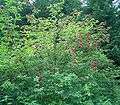Sambucus racemosa
| Sambucus racemosa | |
|---|---|
| | |
| Scientific classification | |
| Kingdom: | Plantae |
| (unranked): | Angiosperms |
| (unranked): | Eudicots |
| (unranked): | Asterids |
| Order: | Dipsacales |
| Family: | Adoxaceae |
| Genus: | Sambucus |
| Species: | S. racemosa |
| Binomial name | |
| Sambucus racemosa L. | |
| Subspecies | |
| |
Sambucus racemosa is a species of elderberry known by the common names red elderberry[2] and Red-berried Elder.[3]
Distribution and habitat
It is native to Europe, northern temperate Asia, and North America across Canada and the United States.[1] It grows in riparian environments, woodlands, and other habitats, generally in moist areas.[4]
Description
Sambucus racemosa is often a treelike shrub growing 2–6 metres (6.6–19.7 ft) tall. The stems are soft with a pithy center.
Each individual leaf is composed of 5 to 7 leaflike leaflets, each of which is up to 16 centimeters long, lance-shaped to narrowly oval, and irregularly serrated along the edges. The leaflets have a strong disagreeable odor when crushed.[5]
The inflorescence is a vaguely cone-shaped panicle of several cymes of flowers blooming from the ends of stem branches. The flower buds are pink when closed, and the open flowers are white, cream, or yellowish. Each flower has small, recurved petals and a star-shaped axis of five white stamens tipped in yellow anthers. The flowers are fragrant and visited by hummingbirds and butterflies.[4]
The fruit is a bright red or sometimes purple drupe containing 3 to 5 seeds.
Varieties and subspecies
- Sambucus racemosa subsp. kamtschatica — red elder, native to Northeastern Asia. [6]
- Sambucus racemosa var. melanocarpa — Rocky Mountain elder, native to the Western United States and Western Canada, including the Rocky Mountains and Sierra Nevada. [7] [8] [9]
- Sambucus racemosa subsp. pubens — American red elder, native to Eastern North America
- Sambucus racemosa subsp. racemosa — European red elder. [10]
- Sambucus racemosa var. racemosa — Pacific red elderberry. [11][12] [13]
- Sambucus racemosa subsp. sibirica — red elder, native to Siberia. [14]
- Sambucus racemosa subsp. sieboldiana — Japanese red elder
Uses
The stems, roots and foliage are poisonous, and the berries can be toxic or cause nausea if eaten raw. [15]
Medicinal plant
It has been used as a traditional medicinal plant by Native Americans, including the Bella Coola, Carrier, Gitksan, Hesquiaht, Menominee, Northern Paiute, Ojibwa, Paiute, and Potawatomi peoples.[4] [16] The uses included as an emetic, antidiarrheal, cold and cough remedy, dermatological and gynecological aid, and a hemostat. [16]
Food
The fruits are reportedly safe to eat when cooked, but are potentially poisonous when raw. They were cooked in a variety of recipes by Native Americans, including by the Apache, Bella Coola, Gitxsan, Gosiute, Makah, Ojibwa, Quileute, Skokomish, Yurok peoples.[4]
The fruits are popular with birds, who also distribute the seeds.[17] The flowers attract butterflies and hummingbirds. [15]
Cultivation
Sambucus racemosa is cultivated as an ornamental plant, for use as a shrub or small tree in traditional and wildlife gardens, and natural landscape design projects. [15]
Cultivars
Cultivars in the nursery trade include:
- Sambucus racemosa 'Black Lace' — burgundy foliage. [18]
- Sambucus racemosa 'Lemon Lace' — golden yellow and green foliage. [19]]
- Sambucus racemosa 'Lemony Lace' — golden green foliage, with red new growth. [20]
- Sambucus racemosa 'Sutherland Gold' — green foliage, with bronze new growth. [21] It received the Royal Horticultural Society's Award of Garden Merit.[22]
Images
- Leaves and buds of the red elderberry
- Inflorescence and foliage
 Clusters of berries
Clusters of berries Natural range of S. racemosa var. racemosa (green) and var. melanocarpa (blue) in western North America.
Natural range of S. racemosa var. racemosa (green) and var. melanocarpa (blue) in western North America.
References
- 1 2 Sambucus racemosa was originally described and published in Species plantarum 1:270. 1753. GRIN (October 9, 2003). "Sambucus racemosa information from NPGS/GRIN". Taxonomy for Plants. National Germplasm Resources Laboratory, Beltsville, Maryland: USDA, ARS, National Genetic Resources Program. Retrieved December 8, 2012.
- ↑ "Sambucus racemosa". Natural Resources Conservation Service PLANTS Database. USDA. Retrieved 28 October 2015.
- ↑ "BSBI List 2007". Botanical Society of Britain and Ireland. Archived from the original (xls) on 2015-02-25. Retrieved 2014-10-17.
- 1 2 3 4 NPIN Database
- ↑ Trees, Shrubs, and Woody Vines of North Carolina: Red Elderberry (Sambucus racemosa var. pubens)
- ↑ ITIS Standard Report Page: Sambucus racemosa ssp. kamtschatica
- ↑ Calflora: Sambucus racemosa var. melanocarpa
- ↑ USDA Plants Profile for Sambucus racemosa var. melanocarpa (Rocky Mountain elder)
- ↑ Jepson eFlora: Sambucus racemosa var. melanocarpa
- ↑ ITIS Standard Report Page: Sambucus racemosa subsp. racemosa
- ↑ Calflora: Sambucus racemosa var. racemosa
- ↑ USDA Plants Profile for Sambucus racemosa var. racemosa (red elderberry)
- ↑ Jepson eFlora: Sambucus racemosa var. racemosa
- ↑ ITIS Standard Report Page: Sambucus racemosa ssp. sibirica
- 1 2 3 NPIN−Lady Bird Johnson Wildflower Center: Sambucus racemosa (Red elderberry)
- 1 2 University of Michigan at Dearborn: Native American Ethnobotany for Sambucus racemosa
- ↑ Pojar, J. & A. MacKinnon. (1994). Plants of the Pacific Northwest. Lone Pine Publishing. ISBN 1-55105-042-0
- ↑ Proven Winners.com: Sambucus racemosa Black Lace
- ↑ [http://www.waysidegardens.com/lemon-lace-sambucus/p/35264/ Wayside Gardens.com: Sambucus racemosa 'Lemon Lace'
- ↑ Proven Winners.com: Sambucus racemosa Lemony Lace
- ↑ Fine Gardening Magazine: Sambucus racemosa Sutherland Gold
- ↑ "RHS Plant Selector - Sambucus racemosa 'Sutherland Gold'". Retrieved 2 June 2013.
External links
- USDA Plants Profile for Sambucus racemosa (red elderberry)
- CalFlora Database: Sambucus racemosa (red elderberry, American red elder)
- Jepson Manual (JM93) treatment of Sambucus racemosa
- Jepson eFlora (TJM2) treatment of Sambucus racemosa
- Burke Museum Profile
- UC Photos gallery — Sambucus racemosa
| Wikimedia Commons has media related to Sambucus racemosa. |